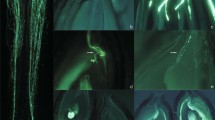Abstract
The quality of Cucurbita pepo L. pollen was studied using field pollinations and the fluorochromatic-reaction test. The extreme sensitivity of this pollen to dehydration and ageing is demonstrated. Controlled stress applied to mature pollen leads to the development of seedless fruits. Molecular signals seem to be involved in the induction of this parthenocarpy. These results indicate the existence of distinct sequences involved in the completion of the fertilization program of pollen. With pollen altered by stress, the fertilization process may be stopped at different stages of its completion. We bring evidence that Cucurbita pepo plants have developed special adaptations in order to compensate for the poor viability of their pollen.
Similar content being viewed by others
Abbreviations
- FCR:
-
fluorochromatic reaction
References
Bar-Shalom, D., Mattson, O. (1977) Mode of hydration, an important factor in the germination of trinucleate pollen grains. Bot. J. Danm. 71, 245–251
Brewbaker, J.L., Kwack, B.H. (1963) The essential role of calcium ion in pollen germination and pollen tube growth. Am. J. Bot. 50 859–865
Dumas, C., Knox, R.B. (1983) Callose determination of pistil viability and incompatibility. Theor. Appl. Genet. 67, 1–10
Gaget, M., Said, C., Dumas, C., Knox, R.B. (1984) Pollen-pistil interactions in interspecific crosses of Populus (sections Aigeiros and Leuce). Pollen adhesion, hydration and callose response. J. Cell Sci. 72, 173–184
George, W.L., Scott, J.W., Splittstoesser, W.E. (1984) Parthenocarpy in tomato. Hortic. Rev. 6, 65–84
Gilissen, L.W. (1977) The influence of relative humidity on the swelling of pollen grains in vitro. Planta 137, 299–301
Heslop-Harrison, J., Heslop-Harrison, Y. (1970) Evaluation of pollen viability by enzymatically induced fluorescence; intracellular hydrolysis of fluorescein diacetate. Stain Technol. 45, 115–120
Heslop-Harrison, J., Heslop-Harrison, Y. (1985) Germination of stress tolerant Eucalyptus pollen. J. Cell Sci. 73, 135–137
Heslop-Harrison, J., Heslop-Harrison, Y., Shivanna, K.R. (1984) The evaluation of pollen quality and a further appraisal of the fluorochromatic (FCR) test procedure. Theor. Apl. Genet. 67, 367–375
Jensen, W.A., Ashton, M.E., Beasley, C.A. (1983) Pollen tubeembryo sac interaction in cotton. In: Pollen: Biology and implications for plant breeding, pp. 67–72, Mulcahy, D.L., Ottaviano, E., eds. Elsevier, New Jork Amsterdam Oxford
Knox, R.B., Williams, E.G., Dumas, C. (1986) Pollen, pistil and reproductive function in crop plants. In: Plant breeding reviews, vol. 4, pp. 9–79 Janick, J., ed. Avi Publ. Westport (in press)
Visser, T., Verhaegh, J.J. (1980) Pollen and pollination experiments. 2. The influence of the 1st pollination on the effectiveness of the 2nd one in apple. Experientia 29, 385–390
Author information
Authors and Affiliations
Rights and permissions
About this article
Cite this article
Gay, G., Kerhoas, C. & Dumas, C. Quality of a stress-sensitive Cucurbita pepo L. pollen. Planta 171, 82–87 (1987). https://doi.org/10.1007/BF00395070
Received:
Accepted:
Issue Date:
DOI: https://doi.org/10.1007/BF00395070




